Apple MacBook Pro 13: Can a Mac Be a Decent Windows Laptop?
by Vivek Gowri on October 14, 2010 9:00 PM ESTApple MacBook Pro 13—Core 2 Duo Performance
It’s kind of embarrassing to be reviewing a $1200 computer with a two year old processor and application performance to match. It’s not that evident in day to day use, and in most games performance is more dependant on the graphics card, but application performance benchmarks are where the Core 2 Duo really makes itself felt (and not in a good way).
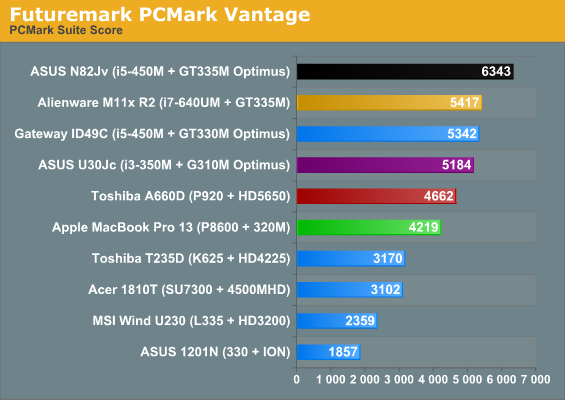
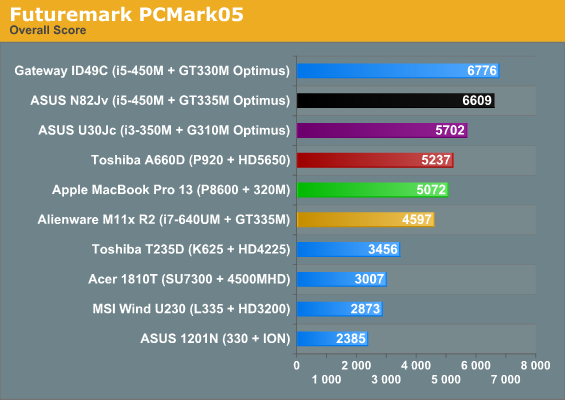
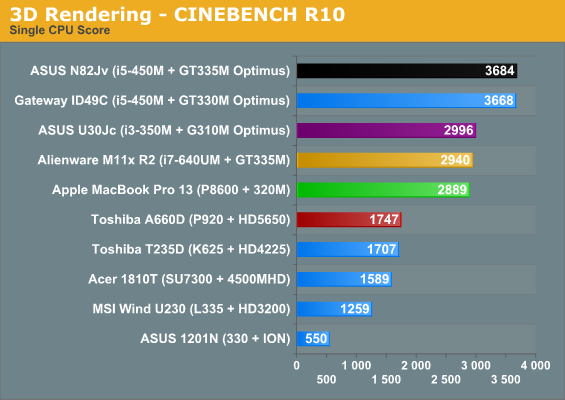
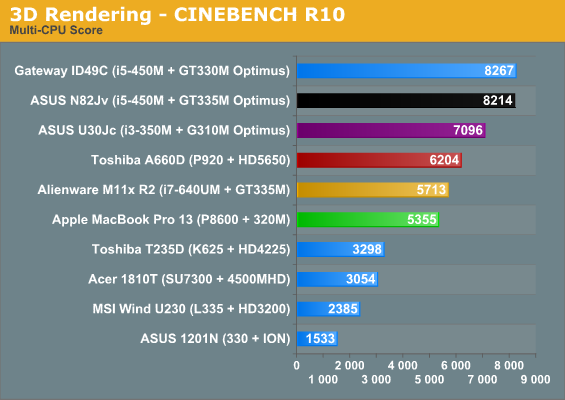
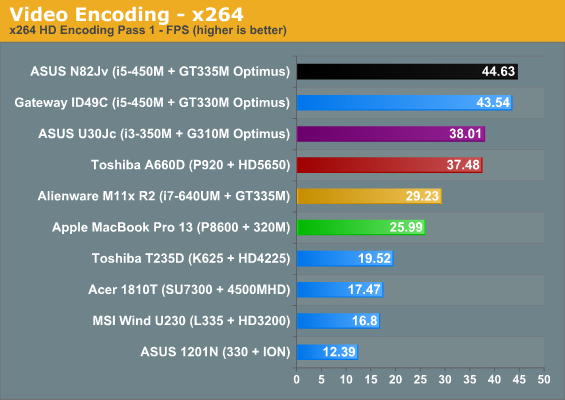
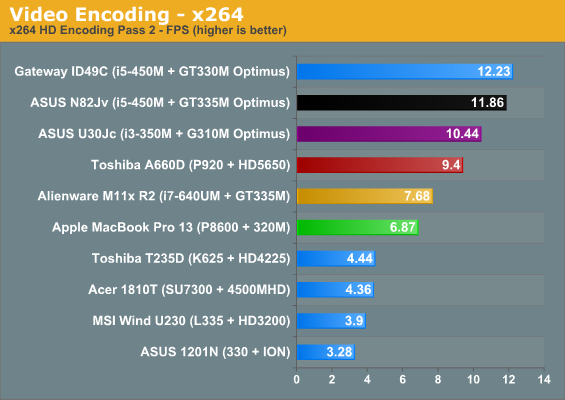
Here’s why it’s really sad: the MBP13 results would fit pretty well in our old Core 2 Duo notebook roundups, like this one from two years ago. The G50V and dv5t were $1200 notebooks back then, and they’re basically on par with the current MBP13. Quite frankly, it’s almost pathetic that Apple decided they could get away with a Core 2-based processor for another year at a price point that can get you a 14” aluminum unibody notebook with a quad core i7-720QM (HP, we’d still like to test an Envy 14, thanks). People expect Macs to cost more almost by default, but after a couple of years of the MBP13 being a decent value for a premium quality notebook (look at the old Envy 13 for comparison), it’s particularly jarring now to see it be so far behind the competition. I have none of these complaints for the Core i5/i7 sporting 15” and 17” models, however.
At this juncture, any notebook with a Core i3 can outrun the MBP. Same goes for the Core i7 ULV chip. We’ve never tested a Core i5 ULV, but we'll see the Core i3 ULV in a review shortly and it's in the same ballpark as Core 2—and the overclocked Core i3-330UM in the ASUS UL80Jt is basically on par with the MBP.
There are two ways you can look at this; you can say that at this point, anything with a Core 2 (even an old Merom) is more than powerful enough to run Windows and handle any reasonable task a thin and light notebook might be asked to. A lot of Apple fans say that. There’s another camp that says it’s completely unreasonable for Apple to sell a notebook with a Core 2 Duo processor at $1200, regardless of what it might be asked to do—there are smaller, thinner, lighter systems that perform better in basically every way. A lot of anti-Apple fans say that. They’re both right.
The Core 2 Duo is most certainly adequate to handle the normal, every day rigors of a portable notebook, but that’s not a reasonable justification for Apple selling a notebook that is more expensive than more powerful competitors. Apple is getting a bargain price on P8600 CPUs and the 320M chipset, which means the Core 2 + 320M is more about increasing profit margins than anything else. (And for those people who still cling to the theory that Apple couldn’t fit a third chip onto the board without reducing the battery size or making the notebook larger, that’s nonsense. If ASUS can manage to fit a Core 2010 processor, the chipset, and a dedicated graphics card into a system with similar dimensions to the MBP13 and a 33% larger battery, then Apple could have too. Simple as that.)
While we're here, we also ran all the 3DMark suites. This hints at the Core 2 + 320M combination being a lot more impressive than the above results, but then why couldn't Apple get GT 320M or faster with switching graphics into the system instead? Oh, right: that's only for 15" and 17" MBP. More on this when you hit the next page.
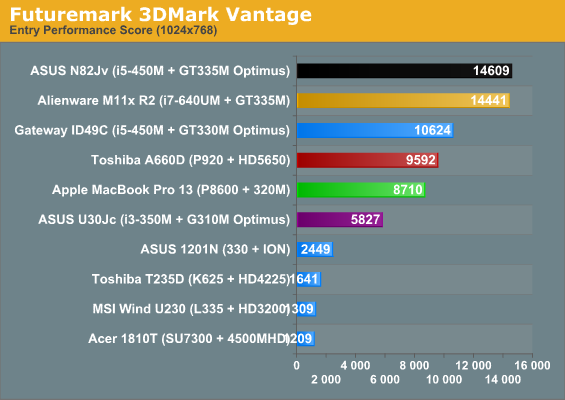
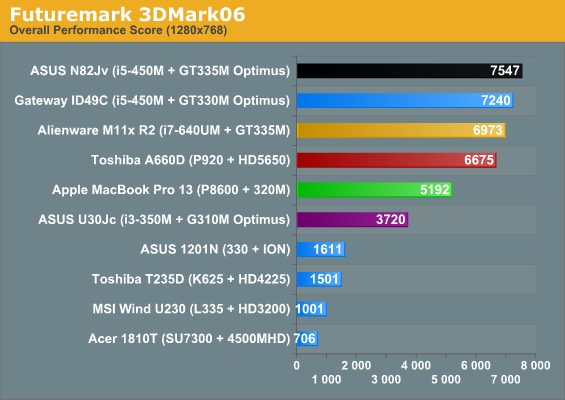
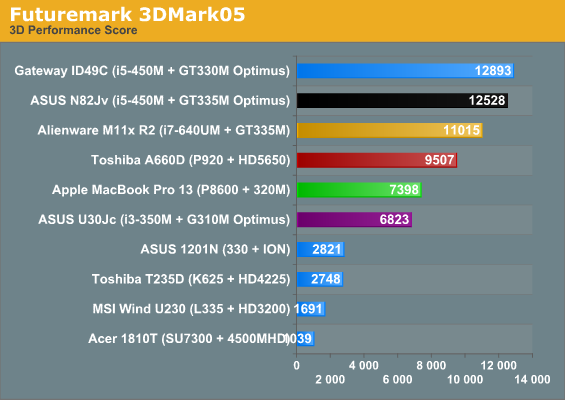
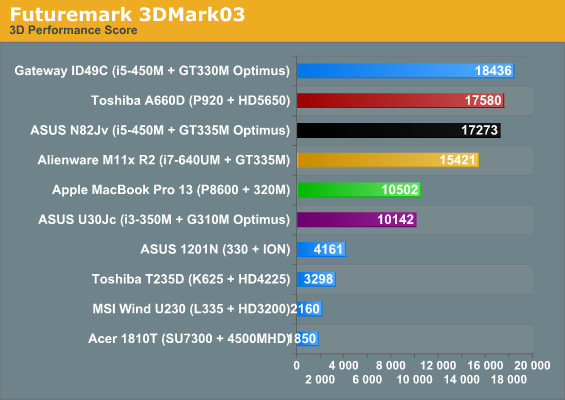
Okay, 320M looks decent, but the CPU is still old. We'll get into the graphics stuff on the next page, but while we're here looking at 3DMarks, we do have a quick question: how many of you want us to continue posting 3DMark results with our laptop reviews? We know they're a consistent point of reference for the long-term, but 03 and 05 in particular are getting very long in the tooth. So, if you want to sound off in the comments, would you like us to ditch 3DMark entirely, keep 06 and Vantage, keep all four like we've got above, or only skip 03/05?










117 Comments
View All Comments
MrDiSante - Friday, October 15, 2010 - link
Regardless, Apple is notorious for shoddy Windows drivers (and shoddy Windows software in general - iTunes, Safari, QuickTime, need I go on?)tipoo - Thursday, October 14, 2010 - link
The 13'er doesn't have a dGPU. Must be something else.dagamer34 - Thursday, October 14, 2010 - link
Charging $1200-1500 for what is essentially a 2 year old laptop is one reason why I can only buy a MacBook Pro every 2-3 years where the "Apple tax" really rears it's head when it comes to performance per dollar across all lines of notebooks.solipsism - Thursday, October 14, 2010 - link
“If ASUS can manage to fit a Core 2010 processor, the chipset, and a dedicated graphics card into a system with similar dimensions to the MBP13 and a 33% larger battery, then Apple could have too. Simple as that.”How is it as simple as that? I’ve seen the Asus to which you refer and it’s significantly thicker over most of the chassis. That means more vertical space for cooling and more room for heat sinks fan or whatever for placing a dGPU. It also means more vertical space for the battery so even if it’s 33% larger it could have a lower footprint thus allowing the Asus MoBo be larger for that dGPU.
If you considered this and now for a fact that the MoBo isn’t larger then please post some images or links to images disproving this possible reason.
"Apple products aren’t reknowned for their value for money quotient, but even by Apple standards, this is pretty bad.”
If you are going to define “value” as the cost of a computer based on the type of processor used or it’s rating in a speed bench then you should denote that is exactly what you mean, because there is a lot of value that can be had from a system that focuses on a complete package and has a resale “value” much higher than other vendor’s systems. By what I assume must be your definition of “value” any notebook is crap because a desktop can be had at a cheaper price with a faster processor.
Finally, you seem to be basing your price of the entire product on the performance of the CPU. How does this make any sense? Personally, I’d rather have a C2D with a better GPU than the i3 with IntelHD. I’m also willing to pay more for a better chassis, better display, better trackpad and those little things that this article triumphed and then latter pooh-poohed as being irrelevant to the cost of the entire system.
if you need/want the fastest the processor that’s fine, but for many the CPU is already fast enough, it’s the other things that are lacking in most vendor’s machines. Same goes for the display resolution. I can’t tell you how many times I’ve seen people determine which is “best” by only looking at the resolution and aspect ratio.
Honestly, I wish more PC and CE companies would focus on details that aren’t easy to market on a spec sheet.
VivekGowri - Friday, October 15, 2010 - link
What about the Sony VAIO Z? That's smaller, and has the Core i5, a dGPU, plus space for two solid state drives (yes, I know it's significantly more expensive). The Asus was just an example, there's plenty of other 13" notebooks to choose from that have Core 2010 and a dedicated graphics card.See, the MBP13 and 13" Aluminum MacBook were a decent value right until most of the world moved to Core i3/5/7. A $1200 notebook with a two year old processor is not a good value, regardless of how you try to spin it.
GeorgeH - Friday, October 15, 2010 - link
Smaller? The Z is ~120% of a 13" MBP.VivekGowri - Friday, October 15, 2010 - link
Wait, what? The VAIO Z weighs 3.04lbs...that's 50% less than an MBP13. Same thickness as the MBP (don't believe the specsheet; the body is an inch across, but the rubber grips in the back raise it up higher), smaller footprint, etc.GeorgeH - Friday, October 15, 2010 - link
Aluminum is heavier (denser) than plastic. You're right about the footprint, and I acknowledge the Vaio has the little foot, but I'd bet my lunch money the Z displaces more volume.Maybe you can get Apple and Sony to agree to a liquid submersion test? ;)
VivekGowri - Friday, October 15, 2010 - link
http://www.apple.com/macbookpro/specs-13inch.htmlClick the Specifications tab here.
http://www.sonystyle.com/webapp/wcs/stores/servlet...
Do the math. If it's got a smaller footprint and is nearly the same thickness, how would it displace more volume?
And for the record, the Z is carbon fibre, not plastic.
doobydoo - Friday, October 15, 2010 - link
We have both the 13 inch macbook pro and the Sony Vaio Z, and the Sony Vaio Z is significantly lighter, smaller, and faster (we have one of the RAID SSD Models). It also looks more stylish, has at least as good build quality, and all the other features you might look for such as an illuminated keyboard.We have a case specifically for the Macbook pro which fits snugly, but when we put the Vaio in there there are inches of room all around the case, so I am very confident that the Vaio is significantly smaller in terms of volume, as well as the already proven weight and footprint.
It's a better all round laptop, extremely long battery life, every good feature you would need, stays extremely cool (whilst running Windows 7), lightning fast even in Stamina mode (6-8 hours battery), smaller, much lighter, amazing screen, and excellent build quality.
I'd recommend the Vaio every day of the week.
To respond to another comment, where the guy said that Apples are partially more expensive due to the development costs of OS X, are you completely forgetting that every laptop comes with an OS, which adds to their cost too? And a better OS, at that.